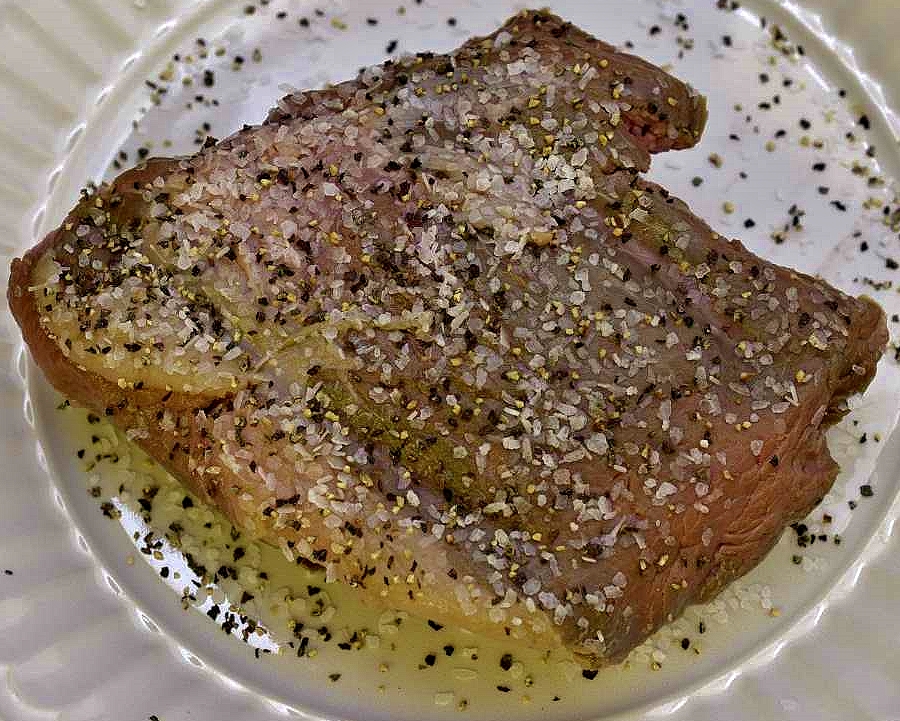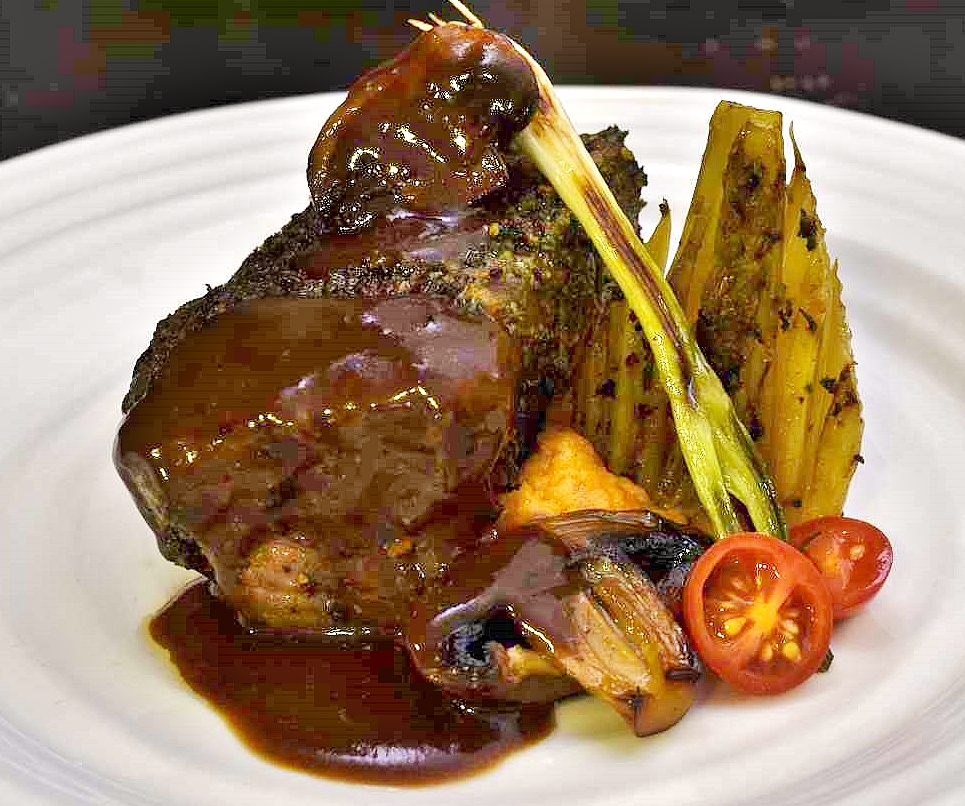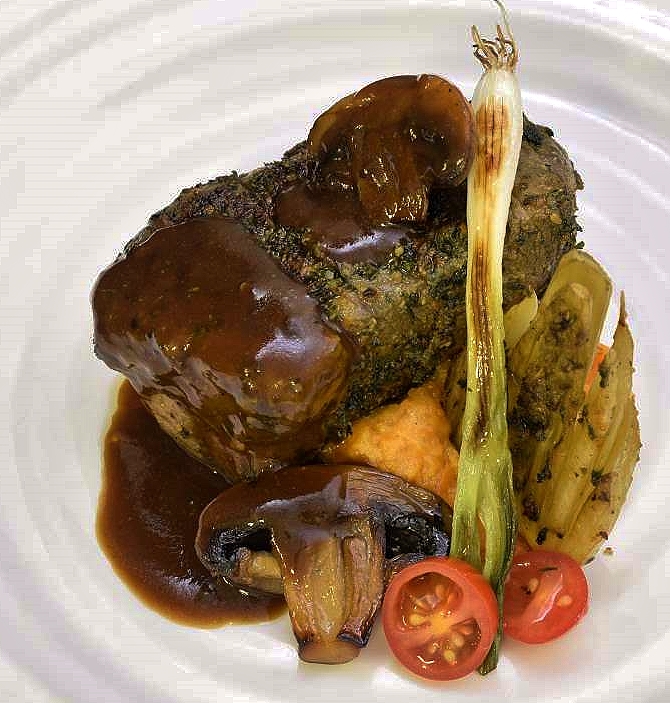Starting Blocks
Originally designed for beginners, this commentary can benefit even the most experienced sous vide practitioners. While most premium cut steaks do not require tenderization, sous vide aficionados use the technology to create a uniform appearance of doneness throughout the steak and to retain moisture.
When it comes to tri-tip/bottom sirloin, people have resigned themselves to a certain amount of chewiness inherent in this cut. We justify this by noting its typically competitive price point. This no nonsense, straightforward approach to processing and serving the cut demonstrates the value added tenderization characteristics of sous vide. In turn, the practitioner is liberated from the crossed finger, “hope for the best” outlook when serving a tri-tip to family or friends.
How it comes
Beef tri-tip is marketed in several different forms in the butcher’s case. While retail markets frequently package the cut portioned into steaks, the popular big-box stores frequently offer the cut whole, either “peeled” or “unpeeled.” This refers to fat trimmed as opposed to fat left on. To this end, we show a few of the alternatives. The trim amounts to about 30% of the total weight. It is too fatty to make ground beef, but it is suitable for making sauces. Click on the link to learn how to make TRI TIP BROWN GRAVY.

After trimming, this 4 lb/1.8 Kg cut yielded five, 8 oz/225 g steaks, and 8 oz/225 g of lean meat removed to achieve uniform shapes for the steaks.

Packaged and ready for the bath.

How it goes
Vacuum sealed in heat rated bags, the steaks were processed at
129 F/54 C for a minimum of eight hours–for this demonstration, we processed the steaks for 12 hours. At this temperature, it is very difficult to over-tenderize the steak. Don’t be afraid to take advantage of sous vide’s unique ability to convert collagen to gelatin–tenderization.
This will create a rare appearance. If you prefer a different appearance of doneness, refer to the guide linked HERE.

Time in the bath determines texture/tenderness, but time in the bath cannot be used to precisely MEASURE tenderness–this requires the acquisition of a small amount of skill, explained HERE.

Once the interval has elapsed and the desired level of tenderness has been achieved, remove the steak from the bag and pat dry with a paper towel. Note the pallid, grayish appearance–this is normal because the cooking process has been isolated from the caramelization/Maillard effect resultant from searing in a hot pan.

Season to your preference, applying up to 2 teaspoons kosher salt/450 g/1 lb. of meat. Most chefs apply ground black pepper in the amount of approximately 15% (by volume) of the amount of salt.
Heat a skillet to at least 350 F/176 C. An infrared thermometer can be used to measure this level of heat, or you can do what most cooks do–when you detect heat radiating from the pan without actually touching the pan, you can begin.

Add enough oil to cover the bottom of the pan This prevents the oil from smoking. The oil itself cannot penetrate the surface of the meat, so make sure you add enough oil to conduct the heat into the steak without adding so much that it splatters out of the pan. Usually one or two tablespoons.

Since the steak is already “mouth hot,” this process will take less than two minutes. Use tongs to turn the steak. Lean it up against the edge of the pan to sear the sides of the steak if desired.
Your steak is ready. We elaborate on some presentations below.

Upgrades
What happens after sous vide processing is almost as important as what happens during the procedure itself. With a little imagination and a few extra touches, you can present your supremely tenderized tri-tip steak as if you were in a white table restaurant.
While you wait for your project to achieve perfection, you have time to turn all that trim into an authentic hotel style sauce. Click the link HERE to learn how.

It has been established that nothing other than sodium ions can penetrate the surface of meat. Even then, this occurs too slowly to be effective during sous vide processing. If you should decide to season your vacuum packed steak for more than a few hours in advance, you may find your end product resembling corned beef more than it does a juicy steak. To find out how the flavorful crust on this steak was created, visit the article entitled Post processing seasonings and rubs.

There is nothing exotic about the ingredients in this presentation. Pureed yams/sweet potatoes are made just like the traditional mashed potatoes model–boiled, drained, mashed or riced and combined with a little butter, cream, salt and pepper. Sauteed mushrooms require but a few seconds in a hot pan with a few drops of oil and lemon juice.
The procedure for making celery hearts is linked HERE. The seared green onion brings altitude–we left its tiny roots attached to bring a little attitude. Grape tomatoes are almost always available, sliced instead of halved in this instance. Drizzled with a little bit of the TRI TIP BROWN GRAVY you will feel the sublime sensation of arrival.






